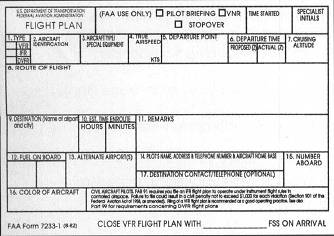Microsoft Flight Simulator Handbook
by Jonathan M. Stern
Flight Plan
In most instances, an instrument flight is initiated by filing with the FAA an instrument flight plan. An instrument flight plan contains the following items:
- Aircraft identification—the registration number assigned by the FAA (in the case of aircraft of United States registry) or the airline name and trip number.
- Aircraft type and special equipment code—for example, C 182RG or LR35. The special equipment code for the Flight Simulator Lear and Cessna is A, which indicates that the aircraft is equipped with DME and an altitude-encoding transponder.
- True airspeed—the true airspeed in knots that you expect to fly at in cruise flight.
- Departure point—the name or three-letter identifier for the airport from which the flight will depart.
- Departure time—the time at which you propose to begin your flight, stated in Universal Coordinated Time (formerly Greenwich Mean Time).
- Cruising altitude—the initial altitude at which you want to cruise.
- Route of flight—the route that you want to follow to get from your departure airport to your destination airport. The route may be defined by airways, NAVAIDS, or direct.
- Destination—the name or three-letter identifier for the airport at which you plan to land.
- Estimated time enroute—the time you estimate that it will take you to fly from your departure airport to your planned destination.
- Remarks.
- Fuel on board—the endurance of the airplane in hours and minutes based on the fuel quantity and the fuel consumption rate for your planned power settings.
- Alternate airport—the name or three-letter identifier of an alternate destination airport.
- Pilot's name, address, and phone number.
- Number on board—the total number of passengers and crew members on board the airplane.
- Aircraft color.
Figure 15.3 is an FAA Flight Plan form in blank. After being filed, the flight plan information is entered into a computer by the FAA. Shortly before the proposed departure time, a flight progress strip is automatically printed in the control tower of the departure airport and in the departure control facility (radar or nonradar) associated with the departure airport.

The flight progress strip contains some, but not all, of the information contained in the flight plan. Figure 15.4 shows a sample flight progress strip generated in a departure control facility. This flight progress strip shows that Piper Cheyenne N5302D, an airplane equipped with RNAV and a transponder with altitude encoding capability, plans to depart Oakland International Airport at 06:18, climbing to 8,000 feet, with a route of flight departing over COLLI and PITTS intersections.

Table of Contents
Previous Section: Landing-Runway Required
Next Section: The Newfangled Way
